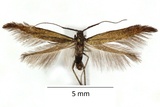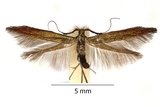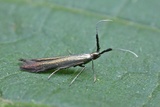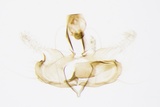Coleophora mayrella (Hübner, [1813]) Species
Last modified: Nov. 28, 2025, 12:31 p.m.
A fairly common species throughout Belgium.
Details
- Classification
- Family: Coleophoridae > Genus: Coleophora > Species: Coleophora mayrella
- Vernacular names
- Kamsprietkokermot (NL), Meadow case-bearer (EN), Hasenklee-Sackmotte (DE)
- Synonyms
- Coleophora fabriciella (De Villers, 1789), nec (Swederus, 1787) and Coleophora spissicornis (Haworth, 1828)
- First mention in Belgium
- De Fré Ch. 1858. Catalogue des Microlépidoptères de la Belgique. — Annales de la Société entomologique belge 2: 45–162. On page 140 (as C.[oleophora] Mayrella. H.). view page
- Status
-
Native
Distribution
Imago
Wingspan 9,5–13 mm.
The forewings are metal-green-golden, sometimes with a purplish shine and slightly darkened at the tip of the wings.
The base of the antennae is clearly thickened to nearly half the length.
The antennae are ringed alternately black and white till 3/5 to the tip.
Case
The larvae live in a reddish brown case, made of a dried floret.
See also bladmineerders.be.
Bionomics
The eggs are deposited on the flowers of the host plant.
The case is built in the later stages and is very difficult to find between the florets.
Pupation in the case, usually attached to the vegetation.
The adults are active in sunshine and later come sparsely to light.
Flight periods
The adults fly mainly during June and July.
Observed on
- Host plant (species):
- Trifolium repens
Monophagously on Trifolium repens.
Habitat
Where the host plants occur: edges of fields and more or less quiet roads.






